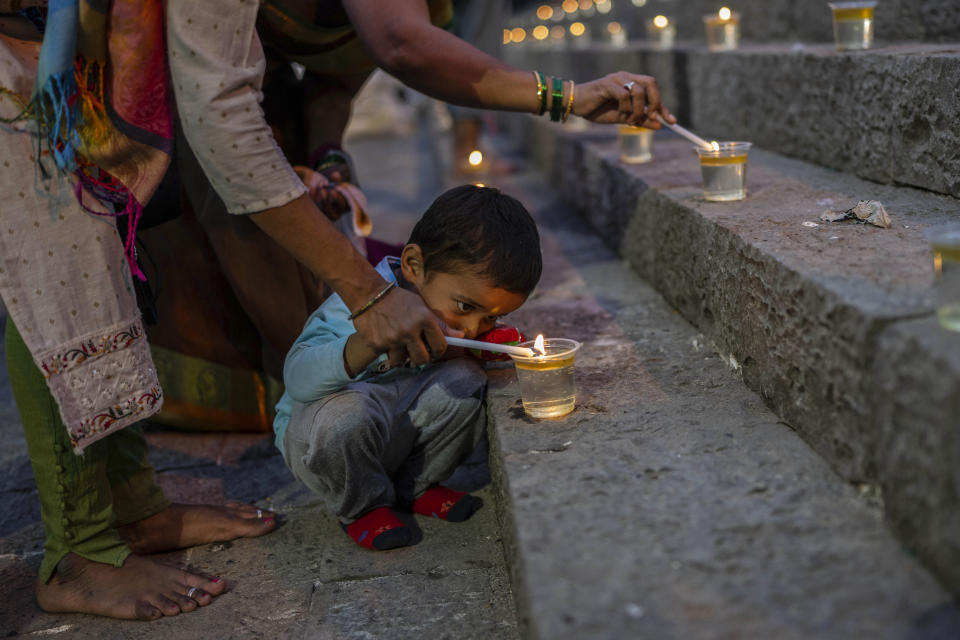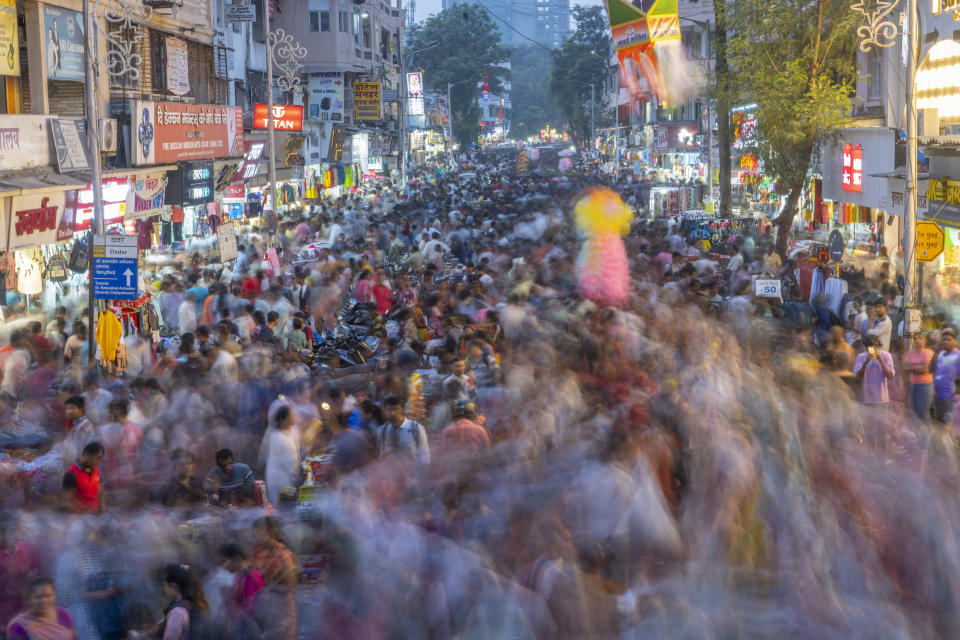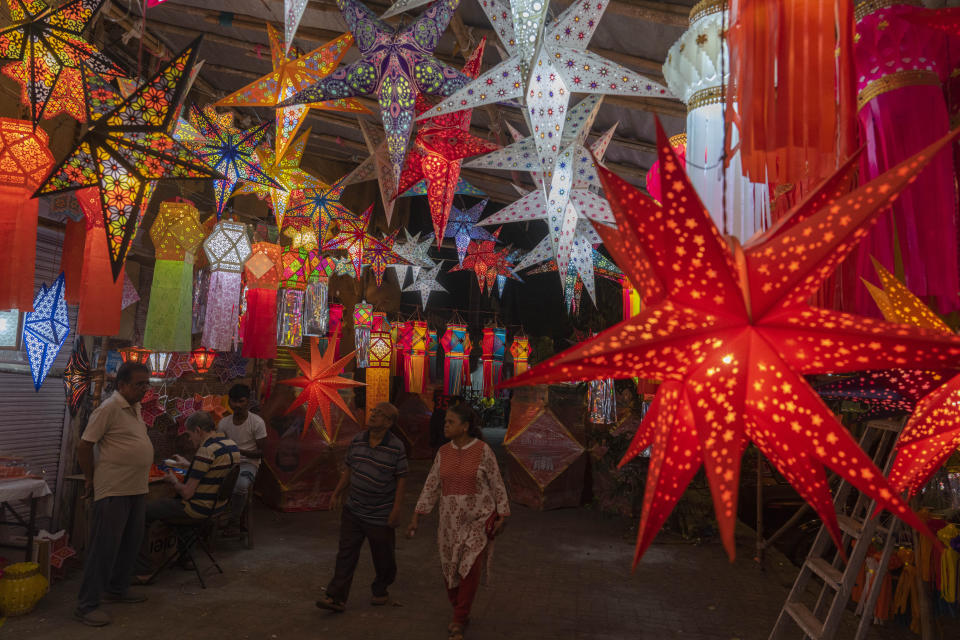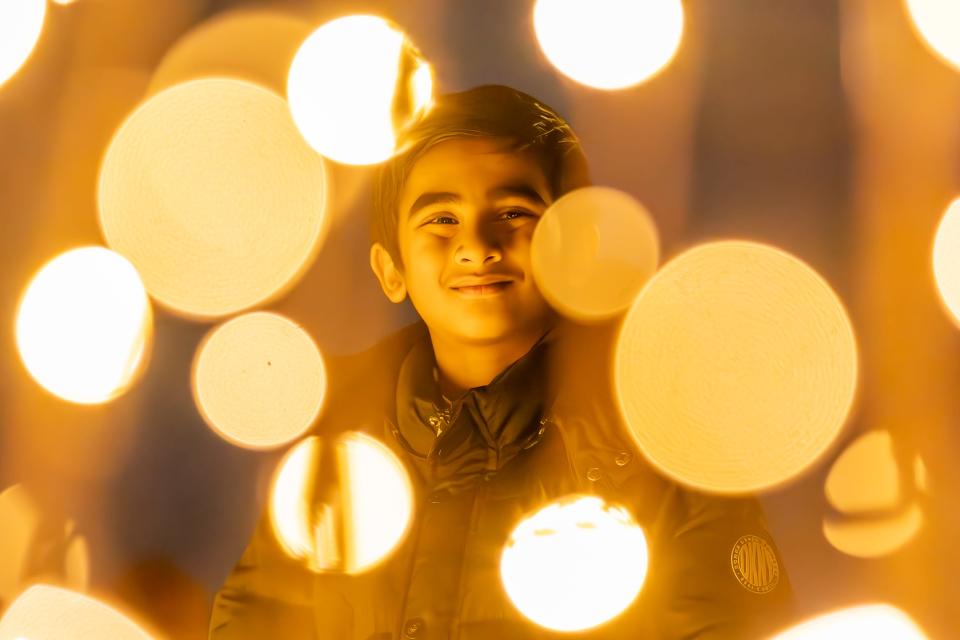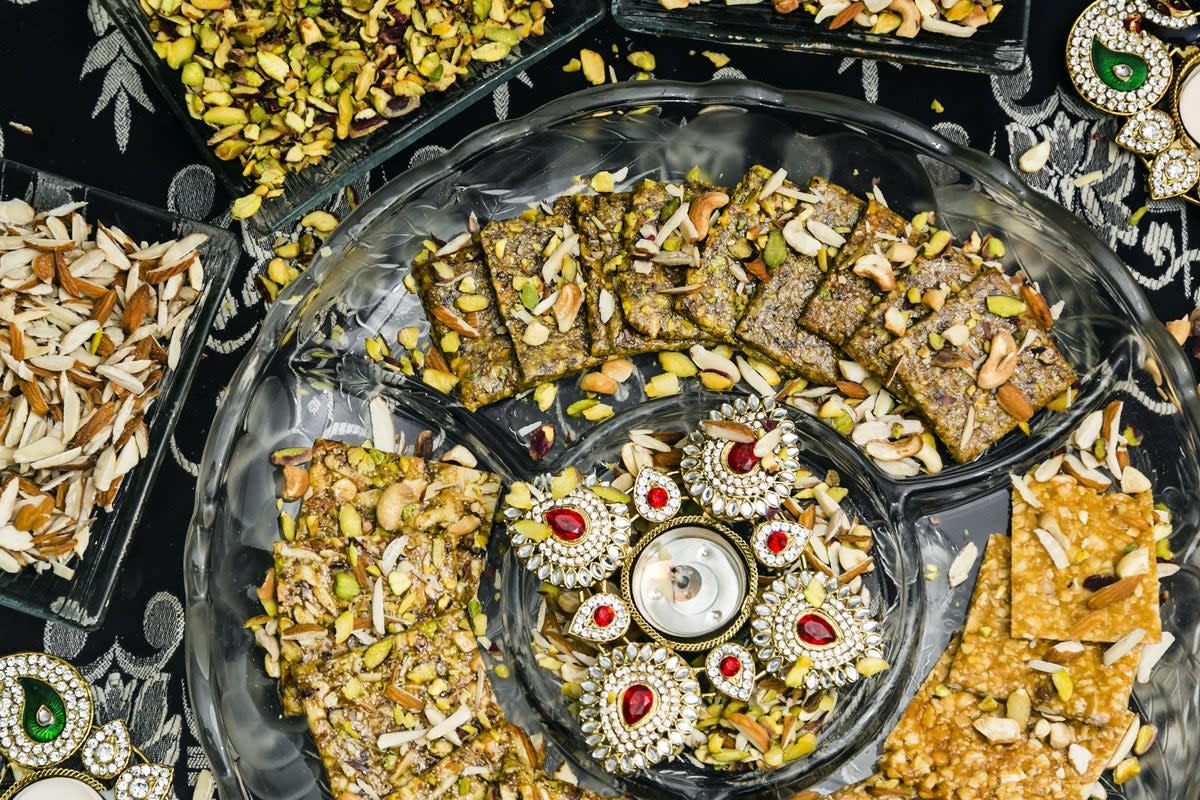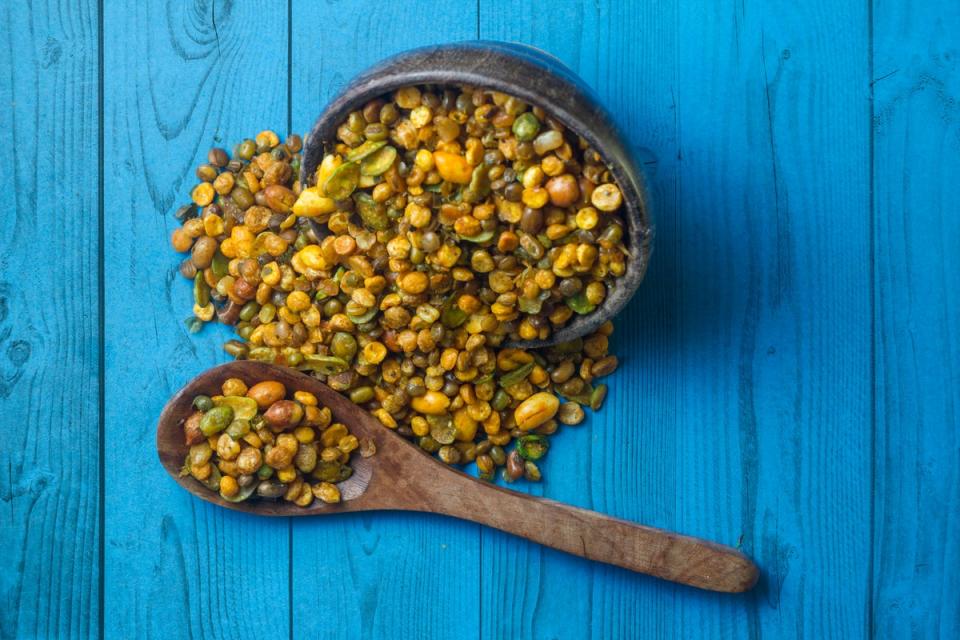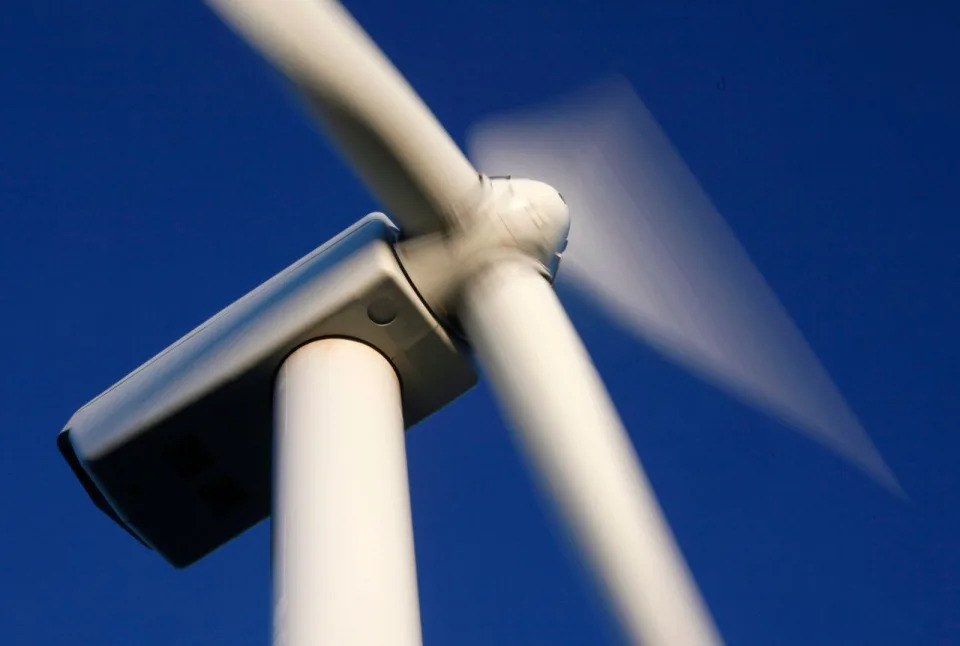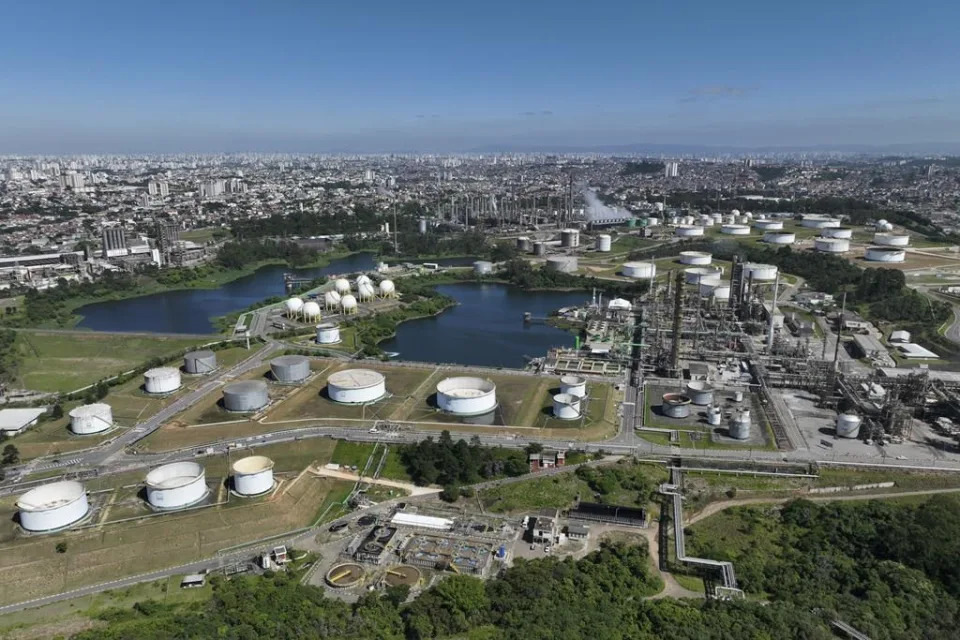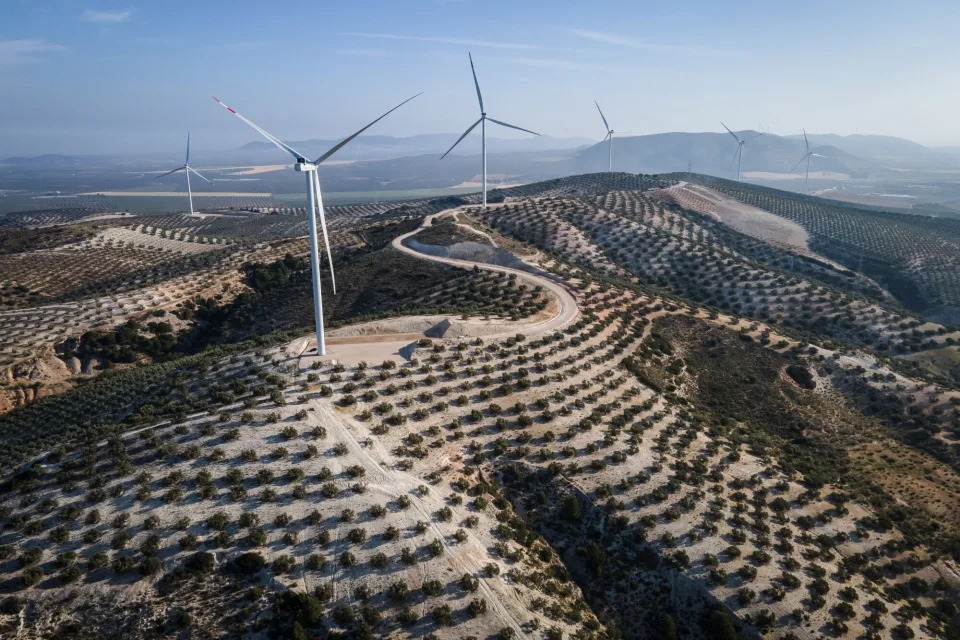Homes decked with lights as annual Hindu festival celebrated across country
:quality(70)/cloudfront-eu-central-1.images.arcpublishing.com/thenational/FPWFSYM5TRIBO3ZAYYBG4HKJSI.jpg)
:quality(70)/cloudfront-eu-central-1.images.arcpublishing.com/thenational/BG7BLVAVP4BPLAA3S6STPJHQ7E.jpg)
:quality(70)/cloudfront-eu-central-1.images.arcpublishing.com/thenational/2JYGT7VP3DRE3FWZBGV7UDWM5Q.jpg)
Devotees light earthen lamps on the banks of the Saryu river in Ayodhya on Saturday. AFP
AP
Nov 12, 2023
Millions of Indians celebrated Diwali on Sunday, setting a Guinness World Record for the number of bright earthen oil lamps, as concerns about air pollution soared in the country.
Across the country, dazzling multi-colored lights decked homes and streets as devotees celebrated the annual Hindu festival of light symbolizing the victory of light over darkness.
But the spectacular and long-awaited lighting of the oil lamps took place as usual on the banks of the Saryu river in Ayodhya, the birthplace of the Hindu deity Rama.
READ MORE
When is Diwali 2023 and how will the festival of lights be celebrated this year?
At dusk on Saturday, devotees lit more than 2.22 million lamps and kept them burning for 45 minutes as religious hymns filled the air at the banks of the river, setting a new world record. Last year, more than 1.5 million earthen lamps were lit.
After counting the lamps, Guinness World Records representatives presented a certificate to Uttar Pradesh state’s top elected official, Yogi Adityanath.
More than 24,000 volunteers, mostly college students, helped prepare for the new record, said Pratibha Goyal, vice chancellor of Dr Ram Manohar Lohia Avadh University in Ayodhya.
Diwali, a national holiday across India, is celebrated by socialising and exchanging gifts with family and friends. Many light earthen oil lamps or candles as fireworks are set off as part of the celebrations.
:quality(70)/cloudfront-eu-central-1.images.arcpublishing.com/thenational/ZLGUA5Y5MGZF2ECIPXPGE6UPCI.jpg)
In the evening, a prayer is dedicated to the Hindu deity Lakshmi, who is believed to bring luck and prosperity.
Over the weekend, authorities ran extra trains to accommodate the huge numbers trying to reach their home towns to join in family celebrations.
Air quality concerns
The festival came amid rising worries about air quality in India.
A “hazardous” 400-500 level was recorded on the air quality index last week, more than 10 times the global safety threshold, which can cause acute and chronic bronchitis and asthma attacks.
But on Saturday, unexpected rain and a strong wind improved the levels to 220, according to the government-run Central Pollution Control Board.
:quality(70)/cloudfront-eu-central-1.images.arcpublishing.com/thenational/QMLL4LCXC33ADPNIYSX2VGBLBM.jpg)
Air pollution levels are expected to soar again after the celebrations end on Sunday night because of the fireworks used.
Last week, officials in New Delhi shut down primary schools and banned polluting vehicles and construction work in an attempt to reduce the worst haze and smog of the season, which has posed respiratory problems for people and enveloped monuments and high-rise buildings in and around India’s capital.
Authorities used water sprinklers and anti-smog guns to control the haze and many people used masks to escape the air pollution.
Almost every year, New Delhi is named as India's city with the worst air quality, particularly in the winter, when the burning of crop residues in neighbouring states coincides with cooler temperatures that trap deadly smoke.
Some Indian states have banned the sale of fireworks and imposed other restrictions to stem the pollution. Authorities have also urged residents to light “green crackers” that emit less pollutants than normal fireworks. But similar bans have often been disregarded in the past.
This year's Diwali celebrations took place as authorities prepared for the January opening of a temple to Rama at former the site of the 16th-century Babri mosque in Ayodhya.
The mosque was destroyed by a Hindu mob with pickaxes and crowbars in December 1992, sparking violence between Hindus and Muslims that left about 2,000 people dead, most of them Muslims. The Supreme Court’s verdict in 2019 allowed a temple to be built in place of the demolished mosque.
:quality(70)/cloudfront-eu-central-1.images.arcpublishing.com/thenational/QMLL4LCXC33ADPNIYSX2VGBLBM.jpg)
:quality(70)/cloudfront-eu-central-1.images.arcpublishing.com/thenational/NDZXPQH7VNU3446N36H63PYM3U.jpg)
:quality(70)/cloudfront-eu-central-1.images.arcpublishing.com/thenational/2S4Z2HBHPW52AYX3HQOKVWCVDU.jpg)
:quality(70)/cloudfront-eu-central-1.images.arcpublishing.com/thenational/QNUCKEPSBHJOALCEOXPQQEYOQQ.jpg)
:quality(70)/cloudfront-eu-central-1.images.arcpublishing.com/thenational/B2JNBES4XGI22MSXJKKDQKZ4K4.jpg)
Smoke clouds Indian capital on Diwali as revellers defy firecracker ban
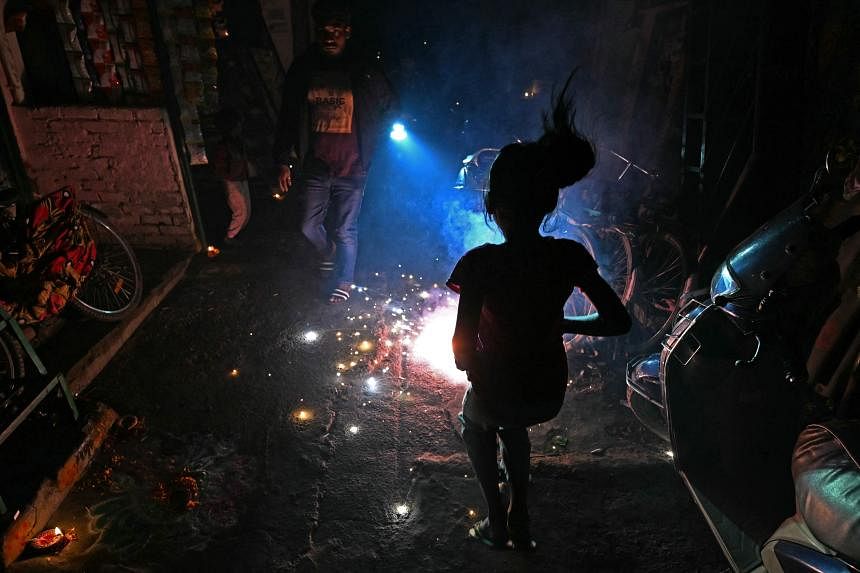 Revellers lighting firecrackers on the night of Deepavali in New Delhi on Nov 12. PHOTO: AFP
Revellers lighting firecrackers on the night of Deepavali in New Delhi on Nov 12. PHOTO: AFP
NEW DELHI – A toxic haze began to circulate in New Delhi on Sunday as people in the city of 20 million, which has struggled with heavy pollution recently, defied a ban on firecrackers on the night of Diwali, the annual Hindu festival of light.
Smoke plumes were visible across the sky as revellers let off firecrackers in the evening to mark the country’s biggest festival.
Every year government authorities or India’s Supreme Court impose bans on firecrackers – but only rarely do those bans appear to be enforced.
The Air Quality Index (AQI) across all 40 monitoring stations in the capital averaged 219 on a scale of 500, according to the federal pollution control board data, indicating “poor” conditions that can affect most people on prolonged exposure.
The AQI data also showed that the concentration of PM2.5 poisonous particulate matter was around 100 microgrammes per cubic m of air – 20 times higher than the World Health Organisation’s recommended maximum.
Globally, air pollution was the worst in India’s eastern city of Kolkata, while Delhi was the fifth-most polluted, according to Swiss group IQAir.
Doctors say the air quality is likely to worsen on Monday as smoke from firecrackers lingers in the air, potentially causing itchy eyes and irritation in the throat.
“I can see my patients are getting distressed. As a society, we have not understood the value of clean air,” said senior consultant Desh Deepak at Delhi’s Dr Ram Manohar Lohia Hospital.
Some Hindus resent the Diwali firecracker bans, which they see as an attempt to interfere with their observing their religious festivals.
Earlier in the day, Delhi Environment Minister Gopal Rai had urged citizens to steer clear of firecrackers to prevent citizens from having breathing problems later.
Just before the weekend, a spell of rain had brought some relief to the city, where the AQI dipped below 160 after hovering around the 400-500 level over the past week.
The world’s most polluted capital typically experiences heavy smog in the winter months as particulate matter gets trapped in the cold air, leading to spikes in cases of respiratory distress.
REUTERS
NEW DELHI – A toxic haze began to circulate in New Delhi on Sunday as people in the city of 20 million, which has struggled with heavy pollution recently, defied a ban on firecrackers on the night of Diwali, the annual Hindu festival of light.
Smoke plumes were visible across the sky as revellers let off firecrackers in the evening to mark the country’s biggest festival.
Every year government authorities or India’s Supreme Court impose bans on firecrackers – but only rarely do those bans appear to be enforced.
The Air Quality Index (AQI) across all 40 monitoring stations in the capital averaged 219 on a scale of 500, according to the federal pollution control board data, indicating “poor” conditions that can affect most people on prolonged exposure.
The AQI data also showed that the concentration of PM2.5 poisonous particulate matter was around 100 microgrammes per cubic m of air – 20 times higher than the World Health Organisation’s recommended maximum.
Globally, air pollution was the worst in India’s eastern city of Kolkata, while Delhi was the fifth-most polluted, according to Swiss group IQAir.
Doctors say the air quality is likely to worsen on Monday as smoke from firecrackers lingers in the air, potentially causing itchy eyes and irritation in the throat.
“I can see my patients are getting distressed. As a society, we have not understood the value of clean air,” said senior consultant Desh Deepak at Delhi’s Dr Ram Manohar Lohia Hospital.
Some Hindus resent the Diwali firecracker bans, which they see as an attempt to interfere with their observing their religious festivals.
Earlier in the day, Delhi Environment Minister Gopal Rai had urged citizens to steer clear of firecrackers to prevent citizens from having breathing problems later.
Just before the weekend, a spell of rain had brought some relief to the city, where the AQI dipped below 160 after hovering around the 400-500 level over the past week.
The world’s most polluted capital typically experiences heavy smog in the winter months as particulate matter gets trapped in the cold air, leading to spikes in cases of respiratory distress.
India’s Yearly Air Haze Carnival is Here!
The real worry for the country should be the high baseline AQI of around 200-250 in almost all major Indian cities.
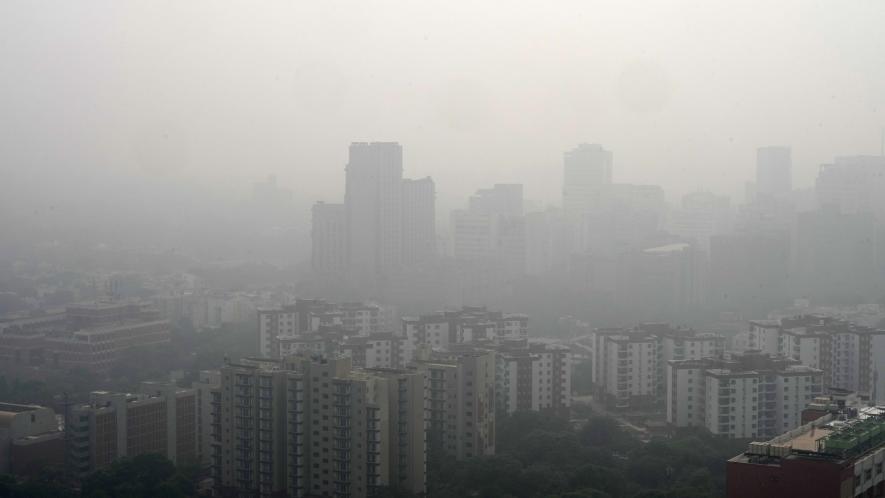
A thick smog blankets the capital city of Delhi, Tuesday, Nov. 7, 2023. Air pollution level is Delhi-NCR has started rising owing much to stubble (parali) burning in adjoining states. Image Courtesy: PTI Photo/Arun Sharma
So here we are once again, regular like the seasons, with Delhi and the entire Indo-Gangetic plains right down to West Bengal, shrouded in a grey haze of pollutants as visible in photographs from space. As many as 13 of the world’s 20 worst polluted cities or towns in the world are in India, including Delhi, satellite towns and other urban centres in northern and eastern India. This has now become such a hardy and recurrent annual feature that it may as well be declared yet another festival of which we already have so many in this country.
As with other Indian festivals, this one too has by now acquired ritual trappings. The press carries daily articles on different aspects, but really only provides snippets of information with little or no meaningful analysis leading to effective policies. The media discourse has utterly confused the issues, and obscured the basic causes behind high levels of air pollution and its major sources, thereby preventing a clear understanding of the problem and a focused policy direction for a long-term and permanent solution.
The same holds true for establishment political parties. The Union government and the ruling dispensation, which daily clamour for control over the administration of Delhi, now only maintains a studious silence, leaving things to a committee and to the different states, while taking pot-shots at Opposition-rules states.
The Delhi government and its ruling party, which used to cry hoarse against the neighbouring states, especially Punjab and Haryana formerly governed by the Congress and Bharatiya Janata Party, respectively, now only speaks against pollutants coming from Haryana, obviously because Punjab is now ruled by the Aam Aadmi Party!
Even the august Supreme Court, which often shies away from important decisions which it says may cross the line separating it from executive or legislative jurisdictions, now questions the basis for different executive decisions, but then proceeds to itself pass orders directing this or that policy or executive action, which too have no basis in science or empirical evidence!
Marx said that history repeats itself, the first time as tragedy, and the next time as farce. But what does one say when a sorry history repeats itself annually?
THE BASICS OF AIR POLLUTION IN DELHI
(AND OTHER INDIAN CITIES)
Let us first get to a basic understanding of the problem of air pollution in urban centres in India.
There is much talk of seasonal or other variations, weather conditions, wind flows, seasonal or other spurts in one or another pollution source, but not clearly identifying the major sources of pollution. Extensive discussions about farm fires in north-western states, the inversion phenomenon in winter wherein cold air stays close to the ground gets trapped, make it appear as if the problem is more acute in North India than in peninsular and southern India. In major coastal cities such as in Mumbai, Chennai and even to some extent Kolkata, sea-breezes regularly flush out air pollutants over these cities, ensuring lower ambient pollution and beguilingly low air quality indices.
It needs to be clearly understood that total pollutants released into the air, especially over cities, come from specific sources in quantities that can be determined by scientific studies and models. The major sources of air pollution in any urban centre in India would mostly comprise vehicle exhaust, coal-fired power plants in the vicinity, brick and other kilns in the region, construction and ambient dust, domestic, industrial or commercial burning of solid fuels such as coal and firewood, open burning of garbage or waste, industrial air pollution including and especially from burning of highly polluting fuels such as rubber and poor grades of furnace oil etc in boilers or other equipment, diesel generators and some other sources.
Of all these, as numerous studies have shown, vehicular pollution, construction and ambient dust, and industrial pollution are the major sources which account for most of the baseline or uniform, underlying air pollution in almost all Indian cities.
The main point here, however, is that, besides these variations and seasonal factors, a finite and determinate quantity of pollutants are emitted from these sources in or near any given city. Out of this total quantity of pollutants, some will stay over these urban centres and their surrounding areas, and some will be blown away or otherwise diffuse through the air due to seasonal and daily variations including rainfall, winds, summer and winter etc.
The Air Quality Index (AQI) is a measure of pollutants determined by sensors placed at different points in the city, and often cited and used to categorise conditions as “good,” “poor” or “severe.” AQI is a good indicator of air pollution under current conditions including as influenced by seasonal and weather patterns, and can help guide additional seasonal or other variable responses. But we need to look closer at the main, or baseline, total air pollutants emitted in and around the city in order to determine, plan and implement long-term strategies to curb air pollution on a permanent basis.
So, if one looks at the numbers, Delhi, surrounding National Capital Region or NCR and other Indo-Gangetic belt cities are being driven to panic by AQI numbers of close to 500 due to seasonal spikes in farm fires and winter conditions. While farm fires etc. can be tackled, the real worry should be the high baseline AQI of around 200-250 in almost all major Indian cities.
KNEE-JERK REACTIONS, FALSE SOLUTIONS
This is certainly not what is being done, or even being addressed, in any city in India or in the country as a whole.
There is a National Clean Air Programme (NCAP) in existence which aims at a 20-30% reduction of PM 2.5 and PM 10 (particulate matter of 2.5 or 10 microns or thousandths of a millimetre size), of which the former is particularly dangerous since it can easily penetrate into the lungs and cause serious respiratory diseases, as compared to 2017 levels. The needle has barely moved on these indicators, and funds have mostly been spent only on providing sensors to different cities. No strategy as such is visible, and no effective inter-departmental coordination mechanism has been set up.
Instead, what the country is witnessing is panic-driven knee-jerk reactions and false solutions offered by all and sundry without any scientific basis or evidence-based reasoning based, among other things, on valuable experiences of other countries which have successfully tackled air pollution in cities over decades resulting in steady and continuing low air pollution today. We shall learn about these in the next section.
In the current tragi-comedy in Delhi, there is first the over-concentration on farm fires in Punjab and Haryana, which have been discussed ad nauseam, including in these columns. Stubble burning is, of course, worrying, but the problem is not amenable to short-being caught between high costs and the urgent need to clear fields of straw to enable planting of winter wheat within an extremely short window of two-three weeks. Various interventions of providing machines and subsidies to various user industries have indeed shown some results, but not enough.
The Centre's Commission for Air Quality Management (CAQM) has reported a substantial decrease in stubble-burning incidents in Punjab and Haryana between September 15 to October 29, of around 56% and 40%, respectively, compared with the same period last year. Yet, as harvest time neared, this has risen again and spiked.
Clearly, more holistic, end-to-end solutions, which cannot simply be left to market forces, are required by state governments with pro-active support and coordination by the Centre. It is pointless for the Supreme Court to peremptorily order the state governments concerned to ensure that all farm fires should be stopped forthwith, as it did earlier this week.
Besides this, the Delhi government decided to introduce its vehicle-rationing “odd-even” (now deferred) scheme under which vehicles with number plates ending with odd or even numbers would ply only on alternative days. The Supreme Court sneered at this idea, asked for evidence to prove that such a scheme works, and sharply called it “sheer optics''. But surely, in theory, a scheme which reduces vehicles on Delhi’s roads by half would cause a substantial dent in air pollution. This was clearly evidenced during the pandemic lockdown when, due to lack of vehicular movement, air quality in Indian cities was better than it had been in several decades!
International experience in Mexico, China and Brazil has shown that such schemes to reduce numbers of vehicles on the roads do indeed work, but have been thwarted to cunning vehicle-owner dissenting response of buying additional vehicles with different number plates to circumvent the “odd-even” norms. In Delhi, two-wheelers which account for 7 million vehicles, have been exempted!
At the same time, the SC asked the Delhi government to consider banning app-based taxis, with the latter then proposing to stop out-of-state taxis from entering Delhi. This would only curb a tiny fraction of the one million vehicles on Delhi’s roads! What evidence does the august court have that this scheme would work?
The same applies to the infamous “smog towers” which the Supreme Court ordered to be installed in 2020 despite evidence-based reluctance of various agencies and academic institutions. Yet, in the past few days, the SC ordered the by now dysfunctional smog towers in Connaught Place to be restarted, even though studies have shown that the tower is effective only over a few tens of metres.
And now the Delhi government is preparing for cloud seeding to produce rain!
More pipedreams.
INTERNATIONAL EXPERIENCE
In sharp contrast to India, Europe as a whole has substantially improved its air quality over the past two decades by concerted and holistic efforts, including strict enforcement of high standards for industrial, vehicular and domestic air pollution by cooking and heating fuels especially coal. These measures have been backed by EU and national legislation, national commitments with strict timelines, and a comprehensive approach tackling all sources of pollution and all major pollutants.
As a result, more than half of EU countries, mostly in Western Europe, have brought down average PM 2.5 levels to under the EU standard of 25 micrograms per cubic metre, compared with the India average of well over 100, and aim to achieve the WHO (World Health Organisation) standard of matter, especially PM 2.5.
The EU has also sharply focused on the dangerous nitrogen dioxide emanating mainly from vehicles and thermal power plants, on surface level ozone, a major carcinogen, and on toxic carbon monoxide, which hardly find mention in the discourse in India. Having earlier tackled power generation and polluting industries, most present efforts are aimed at vehicular pollution.
Another outstanding example is Beijing, widely studied and appreciated by UN agencies and other international agencies. About a decade or two ago, Beijing had the dubious distinction of consistently ranked the most polluted city in the world, with PM 2.5 well in excess of 100. Its smog was notorious, driving many multinational companies and diplomatic missions to seriously consider and publicly speak about relocating out of Beijing.
Even though China as a whole ranked quite poorly in international pollution rankings, it put in highly focused and major efforts into tackling air pollution in Beijing. It moved all coal-based power plants and industries out of the city, ensured phasing out of older and more polluting vehicles, and introduced low-emission zones in the city where only the cleanest or electric vehicles were allowed, an idea also enforced in London and other European cities.
Beijing has been transformed from a car-centred city to what agencies have described as an example of sustainable mobility, expanding urban rail, bicycle and pedestrian mobility. A major afforestation effort was also taken in the northern regions from where recurring dust-storms bringing fine dust into Beijing were curbed.
Widespread use of domestic coal-burning stoves was also curbed. As a result of all these measures, Beijing’s air pollution levels have been reduced by almost half its earlier levels, also bringing down pollution in the huge extended tri-city “megapolis” area.
There is no reason at all why India cannot emulate these international examples. But this would call for political will, planning and enforcement… and stop tilting at windmills!
The writer is with the Delhi Science Forum and All India People’s Science Network. The views are personal.
Let us first get to a basic understanding of the problem of air pollution in urban centres in India.
There is much talk of seasonal or other variations, weather conditions, wind flows, seasonal or other spurts in one or another pollution source, but not clearly identifying the major sources of pollution. Extensive discussions about farm fires in north-western states, the inversion phenomenon in winter wherein cold air stays close to the ground gets trapped, make it appear as if the problem is more acute in North India than in peninsular and southern India. In major coastal cities such as in Mumbai, Chennai and even to some extent Kolkata, sea-breezes regularly flush out air pollutants over these cities, ensuring lower ambient pollution and beguilingly low air quality indices.
It needs to be clearly understood that total pollutants released into the air, especially over cities, come from specific sources in quantities that can be determined by scientific studies and models. The major sources of air pollution in any urban centre in India would mostly comprise vehicle exhaust, coal-fired power plants in the vicinity, brick and other kilns in the region, construction and ambient dust, domestic, industrial or commercial burning of solid fuels such as coal and firewood, open burning of garbage or waste, industrial air pollution including and especially from burning of highly polluting fuels such as rubber and poor grades of furnace oil etc in boilers or other equipment, diesel generators and some other sources.
Of all these, as numerous studies have shown, vehicular pollution, construction and ambient dust, and industrial pollution are the major sources which account for most of the baseline or uniform, underlying air pollution in almost all Indian cities.
The main point here, however, is that, besides these variations and seasonal factors, a finite and determinate quantity of pollutants are emitted from these sources in or near any given city. Out of this total quantity of pollutants, some will stay over these urban centres and their surrounding areas, and some will be blown away or otherwise diffuse through the air due to seasonal and daily variations including rainfall, winds, summer and winter etc.
The Air Quality Index (AQI) is a measure of pollutants determined by sensors placed at different points in the city, and often cited and used to categorise conditions as “good,” “poor” or “severe.” AQI is a good indicator of air pollution under current conditions including as influenced by seasonal and weather patterns, and can help guide additional seasonal or other variable responses. But we need to look closer at the main, or baseline, total air pollutants emitted in and around the city in order to determine, plan and implement long-term strategies to curb air pollution on a permanent basis.
So, if one looks at the numbers, Delhi, surrounding National Capital Region or NCR and other Indo-Gangetic belt cities are being driven to panic by AQI numbers of close to 500 due to seasonal spikes in farm fires and winter conditions. While farm fires etc. can be tackled, the real worry should be the high baseline AQI of around 200-250 in almost all major Indian cities.
KNEE-JERK REACTIONS, FALSE SOLUTIONS
This is certainly not what is being done, or even being addressed, in any city in India or in the country as a whole.
There is a National Clean Air Programme (NCAP) in existence which aims at a 20-30% reduction of PM 2.5 and PM 10 (particulate matter of 2.5 or 10 microns or thousandths of a millimetre size), of which the former is particularly dangerous since it can easily penetrate into the lungs and cause serious respiratory diseases, as compared to 2017 levels. The needle has barely moved on these indicators, and funds have mostly been spent only on providing sensors to different cities. No strategy as such is visible, and no effective inter-departmental coordination mechanism has been set up.
Instead, what the country is witnessing is panic-driven knee-jerk reactions and false solutions offered by all and sundry without any scientific basis or evidence-based reasoning based, among other things, on valuable experiences of other countries which have successfully tackled air pollution in cities over decades resulting in steady and continuing low air pollution today. We shall learn about these in the next section.
In the current tragi-comedy in Delhi, there is first the over-concentration on farm fires in Punjab and Haryana, which have been discussed ad nauseam, including in these columns. Stubble burning is, of course, worrying, but the problem is not amenable to short-being caught between high costs and the urgent need to clear fields of straw to enable planting of winter wheat within an extremely short window of two-three weeks. Various interventions of providing machines and subsidies to various user industries have indeed shown some results, but not enough.
The Centre's Commission for Air Quality Management (CAQM) has reported a substantial decrease in stubble-burning incidents in Punjab and Haryana between September 15 to October 29, of around 56% and 40%, respectively, compared with the same period last year. Yet, as harvest time neared, this has risen again and spiked.
Clearly, more holistic, end-to-end solutions, which cannot simply be left to market forces, are required by state governments with pro-active support and coordination by the Centre. It is pointless for the Supreme Court to peremptorily order the state governments concerned to ensure that all farm fires should be stopped forthwith, as it did earlier this week.
Besides this, the Delhi government decided to introduce its vehicle-rationing “odd-even” (now deferred) scheme under which vehicles with number plates ending with odd or even numbers would ply only on alternative days. The Supreme Court sneered at this idea, asked for evidence to prove that such a scheme works, and sharply called it “sheer optics''. But surely, in theory, a scheme which reduces vehicles on Delhi’s roads by half would cause a substantial dent in air pollution. This was clearly evidenced during the pandemic lockdown when, due to lack of vehicular movement, air quality in Indian cities was better than it had been in several decades!
International experience in Mexico, China and Brazil has shown that such schemes to reduce numbers of vehicles on the roads do indeed work, but have been thwarted to cunning vehicle-owner dissenting response of buying additional vehicles with different number plates to circumvent the “odd-even” norms. In Delhi, two-wheelers which account for 7 million vehicles, have been exempted!
At the same time, the SC asked the Delhi government to consider banning app-based taxis, with the latter then proposing to stop out-of-state taxis from entering Delhi. This would only curb a tiny fraction of the one million vehicles on Delhi’s roads! What evidence does the august court have that this scheme would work?
The same applies to the infamous “smog towers” which the Supreme Court ordered to be installed in 2020 despite evidence-based reluctance of various agencies and academic institutions. Yet, in the past few days, the SC ordered the by now dysfunctional smog towers in Connaught Place to be restarted, even though studies have shown that the tower is effective only over a few tens of metres.
And now the Delhi government is preparing for cloud seeding to produce rain!
More pipedreams.
INTERNATIONAL EXPERIENCE
In sharp contrast to India, Europe as a whole has substantially improved its air quality over the past two decades by concerted and holistic efforts, including strict enforcement of high standards for industrial, vehicular and domestic air pollution by cooking and heating fuels especially coal. These measures have been backed by EU and national legislation, national commitments with strict timelines, and a comprehensive approach tackling all sources of pollution and all major pollutants.
As a result, more than half of EU countries, mostly in Western Europe, have brought down average PM 2.5 levels to under the EU standard of 25 micrograms per cubic metre, compared with the India average of well over 100, and aim to achieve the WHO (World Health Organisation) standard of matter, especially PM 2.5.
The EU has also sharply focused on the dangerous nitrogen dioxide emanating mainly from vehicles and thermal power plants, on surface level ozone, a major carcinogen, and on toxic carbon monoxide, which hardly find mention in the discourse in India. Having earlier tackled power generation and polluting industries, most present efforts are aimed at vehicular pollution.
Another outstanding example is Beijing, widely studied and appreciated by UN agencies and other international agencies. About a decade or two ago, Beijing had the dubious distinction of consistently ranked the most polluted city in the world, with PM 2.5 well in excess of 100. Its smog was notorious, driving many multinational companies and diplomatic missions to seriously consider and publicly speak about relocating out of Beijing.
Even though China as a whole ranked quite poorly in international pollution rankings, it put in highly focused and major efforts into tackling air pollution in Beijing. It moved all coal-based power plants and industries out of the city, ensured phasing out of older and more polluting vehicles, and introduced low-emission zones in the city where only the cleanest or electric vehicles were allowed, an idea also enforced in London and other European cities.
Beijing has been transformed from a car-centred city to what agencies have described as an example of sustainable mobility, expanding urban rail, bicycle and pedestrian mobility. A major afforestation effort was also taken in the northern regions from where recurring dust-storms bringing fine dust into Beijing were curbed.
Widespread use of domestic coal-burning stoves was also curbed. As a result of all these measures, Beijing’s air pollution levels have been reduced by almost half its earlier levels, also bringing down pollution in the huge extended tri-city “megapolis” area.
There is no reason at all why India cannot emulate these international examples. But this would call for political will, planning and enforcement… and stop tilting at windmills!
The writer is with the Delhi Science Forum and All India People’s Science Network. The views are personal.
Killer Delhi Air Reminds, Pollution Needs National Solution
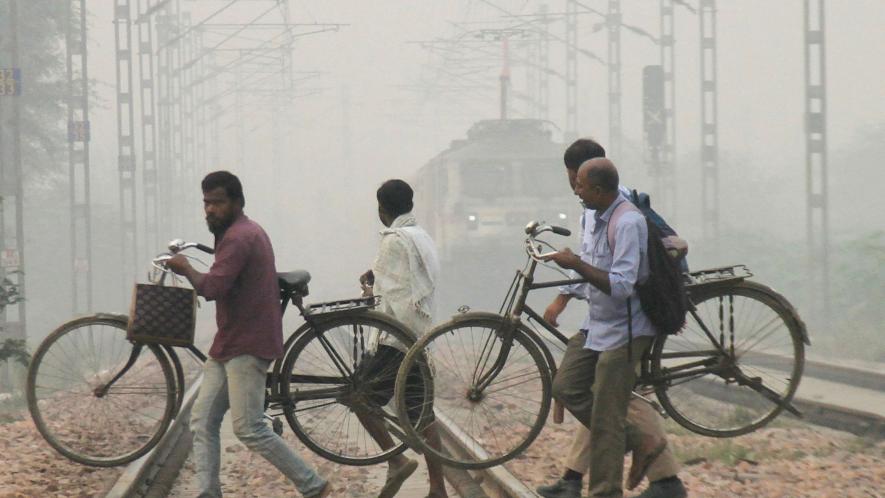
Commuters cross railway tracks amid low visibility due to smog, in Gurugram, Thursday, Nov. 9, 2023. Image Courtesy: PTI
Delhi’s air quality worsens every Diwali season, and this year is no exception. The rainfall in parts of the National Capital Region (NCR) brings some relief, but will hardly change things unless the rainfall is widespread and prolonged—which will have other negative consequences for the economy and people. Hence, Delhi and its surroundings, with the air quality index hitting 500, 100 times above what the World Health Organization (WHO) has deemed healthy, needs to be part of a national solution for the pollution crisis.
The 3.3 crore people living in the NCR are only too aware that the cold-weather smog sees the PM2.5 levels register a dangerous 100% increase, piercing the lungs of citizens and precipitating a host of diseases. On November 2 alone, they recorded a 68% increase in 24 hours. Similar statistics emerged from around the country, making people worried about what miseries the expected spike in pollution with Diwali cracker-burning will bring.
The weary citizens, and especially the elderly and young of this mega city, are asking why the central and state governments, including those of Delhi, Punjab, Haryana and Uttar Pradesh, have failed to get together and draw up a game-plan that will resolve this annual catastrophe that afflicts all? They know that blaming seasonal factors like crop-residue burning and festival-related pollution is not the answer.
However, the seriousness of this matter seems lost on our decision-makers. A few years ago, Dr Arvind Kumar, who headed the Lung Care Foundation at Sir Ganga Ram Hospital, recreated a pair of large human lungs with the help of HEPA (High-efficiency Particulate Air) filters, which are used to trap dust in operation theatres. These “lungs’ were designed to mimic the workings of a pair of human lungs. Dr Kumar had expected the lungs to become dark (signifying high pollution) over time, but they started to darken in just one day and went utterly dark within six days. Dr Kumar said, speaking not only about the effects of pollution in the capital and the entire country, “There are no non-smokers left in India. We have become a nation of smokers.”
The point Dr Kumar was trying to make was that in Delhi, to cite an example, the PM 2.5 levels are high around the year, with doctors insisting this toxic air is the equivalent of smoking over ten cigarettes a day, even for newborn children. With air pollution levels having risen alarmingly across all the major cities of the Indo-Gangetic plain, the situation has become alarming throughout the country.
“This is a failure on the part of individuals, officials, organisations to take cognisance of the fact that breathing is killing [us],” he said in a widely-circulated interview.
Dr Piyush Ranjan from the Department of Medicine AIIMS recently warned, “Air pollution affects various systems of the body apart from causing respiratory diseases. Pollution has direct relations with coronary artery diseases like heart attack, brain stroke and arthritis, and there is scientific evidence to show its relationship with different types of cancer.”
Delhi has set up a Commission for Air Quality Management (CAQM), a statutory body responsible for strategies to combat pollution. It has prepared a graded response plan, and the Grade 4 response has kicked in under the present circumstances. The CAQM has banned diesel BS-4 and all BS-3 private cars and banned diesel-run medium goods vehicles and heavy goods vehicles in the city. But despite a ban on construction activities and the closure of schools until November 26, the ambient air quality has not improved. This is because the root of the problem is not being addressed.
The political class does a great deal of name-calling, with each blaming this mess on the rival party. The Bharatiya Janata Party and the Congress are pointing fingers at the Aam Aadmi Party government in Delhi, blaming it for the present situation given that farm fires are spiking in Punjab. Indeed, reports of these fires continue to come in despite the Supreme Court ordering the Punjab and Haryana governments to ensure farmers stop burning stubble in their fields.
Can AAP escape blame for the crisis in Delhi? According to the Bharatiya Janata Party, the party has failed to provide alternatives to the farmers, resulting in farm fires. Priyanka Kakkar, a party spokesperson, defended her party and called the criticism baseless as she believes Chief Minister Arvind Kejriwal has taken steps to clear Delhi’s air. This includes introducing electric buses, stopping waste burning, and ensuring all industries run on CNG.
According to Kakkar, there were 81,000 farm fires in Punjab in 2016 and only 19,000 in 2023. However, this is contradicted by NASA figures, which paint a very different picture.
She says ensuring 24x7 electricity supply reduced diesel generator use in the capital, unlike Uttar Pradesh and Haryana, where power cuts force industry and housing societies to use diesel generators.
Herein lies the crux of the problem. While there is no doubt that the farm fires helped accelerate the crisis, several neighbouring cities including Ghaziabad, NOIDA, Greater NOIDA and Faridabad report highly hazardous air. According to the Central Pollution Control Board data for the first week of November, Greater NOIDA has the dubious distinction of being the country’s most polluted city. Meanwhile, last year, the World Air Quality Report ranked Delhi the fourth most polluted of 50 cities in the world. This year, Delhi is in an equally bad, if not worse, situation.
How, then, should our planners bring about a turnaround? How should PM 2.5 levels be immediately reduced by 60% to meet the National Ambient Air Quality standards? For one, they must recognise the different sources causing 24/7 pollution around the year. However, the government must also ensure a significant transition from private vehicles to public transport use. In New York and London, exorbitant parking fees have made even the wealthy feel the pinch of driving personal cars and two-wheelers.
By contrast, 1.2 crore vehicles in Delhi were recorded as registered in 2020, though this dipped in the following year. Still, the number of vehicles plying in Delhi on any day exceeds the registered vehicles figure because of cabs from neighbouring cities (which are banned now). Further, trucks and buses using BS 3 diesel supply essential commodities to the city. The government will have to introduce strict laws and restrictions to control private vehicles, but this will only work if there is efficient, reliable and inexpensive last-mile connectivity for public transport, especially the Delhi Metro and bus services.
By and large, industries in Delhi have switched to CNG, but the government needs to take adequate steps to ensure that CNG remains a viable option against the price of coal. If not, people will rely on coal, whatever the environmental consequences.
The other major problem in Delhi is waste management. The CPCB’s annual report for waste management in 2021 revealed that Delhi had the highest per-capita waste generation (450 grams per day), while 263 tonnes of solid waste was generated daily, which is unaccounted for. This is because a lot of trash has been outsourced to private players and is not handled by municipal corporations.
Delhi’s waste-to-energy plants also need to be more efficient. For every tonne of burnt waste, 300 kg of trash is dumped in landfills.
Anumita Roychowdhury, executive director of the Centre for Science and Environment, says, “The states and Centre need to act on a massive scale and with rapid speed to fill some glaring gaps in policy. They must realise that transportation remains the biggest polluter in Delhi, much more than farmers’ fires. The 1.2 crore vehicles plying in the capital add to the traffic congestion on the streets. The government needs to follow a regional approach to resolve this issue, a Delhi-centric approach alone will not work.”
Medical experts say that all sections of society, including politicians, religious leaders and others, must join hands. As Dr Kumar has said, he tried to engage with spiritual figures so they could tell followers what steps to take to curb pollution. Sadly, he claims, he met with little success.
The government continues to be one of the biggest polluters in the NCR, given the number of building projects being undertaken by the Centre. Dust and smoke remain two of the biggest polluters, which can only be curbed if all non-essential construction stops immediately.
Pollution is a deadly killer, and it is questionable how ‘slow’ it is in claiming victims, for India has had unacceptably poor air quality for well over a decade. Unfortunately, governments are blind to the consequences and the toll it has been taking on the country’s entire population.
The author is an independent journalist. The views are personal.
Delhi: Air Quality Severe Again; PM 2.5 at 30 to 40 Times Healthy Limit set by WHO
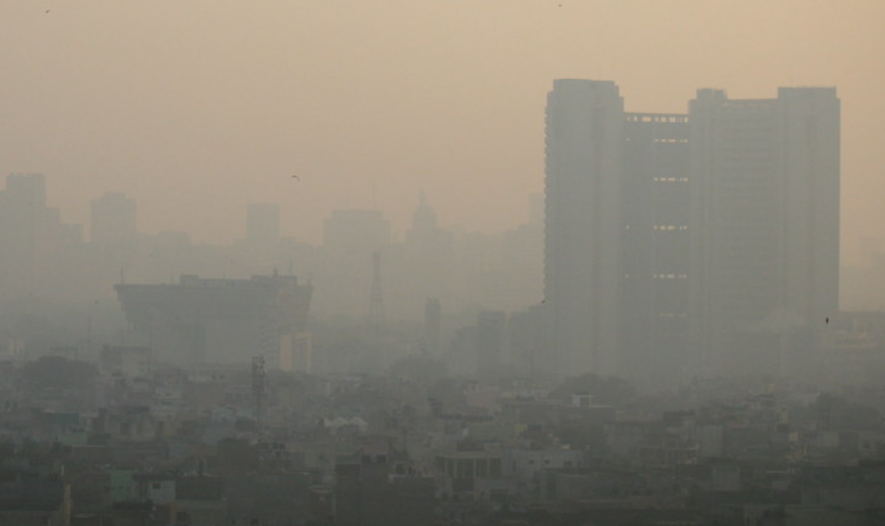
Representational Image. Image Courtesy: Flickr
New Delhi, Nov 8 (PTI) Air quality in Delhi and its suburbs dropped to the severe category again on Wednesday morning, with smoke from post-harvest paddy straw burning in neighbouring states accounting for one-third of the air pollution in the national capital.
The city's Air Quality Index (AQI) stood at 421, worsening from 395 at 4 p.m on Tuesday.
Despite a marginal dip, the concentration of PM2.5, fine particulate matter capable of penetrating deep into the respiratory system and triggering health problems, exceeded the government-prescribed safe limit of 60 micrograms per cubic metre by seven to eight times in the capital.
It was 30 to 40 times the healthy limit of 15 micrograms per cubic metre set by the World Health Organisation (WHO).
Several cities across the Indo-Gangetic plains reported hazardous air quality. Neighbouring Ghaziabad (382), Gurugram (370), Noida (348), Greater Noida (474), and Faridabad (396) also reported hazardous air quality.
According to data from the Decision Support System, a numerical model-based framework capable of identifying sources of particulate matter pollution in Delhi, stubble burning in neighbouring states, especially Punjab and Haryana, accounted for 37% of the air pollution in Delhi on Tuesday. It is likely to be 33% on Wednesday.
The Delhi government on Monday announced the return of its flagship odd-even scheme after four years anticipating further deterioration of air quality post-Diwali.
The odd-even scheme, under which cars are allowed to operate on alternate days based on their odd or even number plates, will be implemented between November 13 and November 20. The Energy Policy Institute at the University of Chicago (EPIC) and Evidence for Policy Design had analysed the impact of the odd-even system in 2016 and found that Delhi saw a 14-16 per cent reduction in PM2.5 levels during the hours it remained in force in January that year. However, there was no reduction in pollution when the scheme was brought back in April that year.
To protect the health of school children, the government also decided to suspend in-person classes in all schools, except for students in grades X and XII preparing for board exams, until November 10.
According to the Ministry of Earth Sciences' Air Quality Early Warning System for Delhi-NCR, the region is likely to experience severe air quality for another five to six days.
Doctors say breathing in the polluted air of Delhi is equivalent to the harmful effects of smoking approximately 10 cigarettes a day.
Prolonged exposure to high levels of pollution can cause or exacerbate respiratory problems such as asthma, bronchitis, and chronic obstructive pulmonary disease (COPD) and can dramatically raise the risk of cardiovascular disease, said Rajesh Chawla, senior consultant in pulmonology and critical care at the Indraprastha Apollo Hospital.
Stringent restrictions mandated under the final stage of the Central government's air pollution control plan for Delhi-NCR, called the Graded Response Action Plan (GRAP), have also been implemented in Delhi.
The restrictions under stage IV of GRAP, including a ban on all kinds of construction work and the entry of polluting trucks into the capital, took effect on Sunday after air quality in the capital dropped to severe plus (AQI above 450) levels.
GRAP categorises actions into four stages: Stage I - Poor (AQI 201-300); Stage II - Very Poor (AQI 301-400); Stage III - Severe (AQI 401-450); and Stage IV - Severe Plus (AQI above 450).
Unfavourable meteorological conditions, combined with vehicular emissions, paddy straw burning, firecrackers, and other local pollution sources, contribute to hazardous air quality levels in Delhi-NCR during the winter every year.
According to a Delhi Pollution Control Committee (DPCC) analysis, the capital experiences peak pollution from November 1 to November 15 when the number of stubble-burning incidents in Punjab and Haryana increases.
Air quality in Delhi-NCR declined over the last two weeks due to a gradual drop in temperatures, calm winds that trap pollution, and a surge in post-harvest paddy straw burning across Punjab and Haryana.
Delhi's air quality ranks among the worst in the world's capital cities.
A report by EPIC in August said that air pollution is shortening lives by almost 12 years in Delhi.




